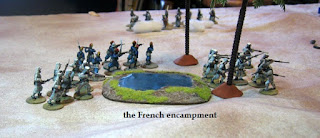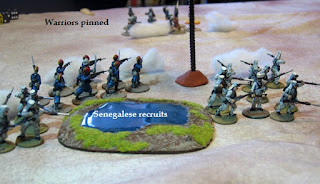Yesterday evening the Fencibles played several games of “The
Men Who Would Be Kings”, henceforth, The Men (etc.). My 28mm French Foreign
Legion (FFL), Senegalese Tirailleurs and Arabs were on duty. We played scenario
G, it’s awfully quiet out there. This is an ambush scenario and hard for the
ambushed side when both sides are armed with rifles.
Bill had the French for the first game, with one squad of
FFL (elite, fierce regular infantry, 8 points) and two squads of Senegalese
(irregular infantry with modern rifles, 5 points each) for a total of 18 points.
Having painted up 4 Askari mules, the French had the mule train too. It could
move (not at the double) but not fight. It could give the French points if it
survived.
The French were deployed around a small oasis, where they
had just broken camp and were getting ready to march away.
The Arabs were Berber tribesmen, 5 bands of irregular
infantry (4 with field craft @ 5 points, 1 without @ 4 points) for a total of
24 points. We could deploy adjacent to any or all edges of the table. I
deployed 3 bands (2 with field craft) from one long edge while Rick deployed
two bands from the opposite side. I now discovered that my camera battery had
run down, so no pictures of the first game.
My bands opened fire at long range, scoring hits and pinning
a Senegalese squad. Rick had sand dunes between him and the French so he rushed
forward. The Senegalese had a lousy rally roll and fled the table without
firing a shot, an ominous omen for Bill. The Legion squad lit out for the
hills. It became obvious later that Bill believed the Legion could exit the
table, whereas the scenario specifies that only attackers can leave the table
voluntarily. Still, the Legion squad was escaping from the killing zone around
the oasis, followed by the mules.
The remaining Senegalese squad was wiped out near the oasis.
One of Rick’s bands managed to move around a dune in time to help put away the
few survivors. With 3 points for each enemy unit wiped out/routed we had 6
points already and we could gain 1 point for each attacking unit that faded off
the table edge before the end of turn 10, so I began fading away. Rick was out
for blood and he pursued the Legion squad with his two bands, also seeking the
mule train. What goodies were packed on the beasts?
Bill, upon discovering that he could not flee the table, turned
back to engage Rick’s tribesmen. I would have backed into a corner of the table
and hoped the tribesmen couldn’t do much damage before the 10th and
last turn. But having his Senegalese wiped out had put Bill into a sanguinary
mood. The Legion did some damage to Rick’s tribesmen but was rapidly wiped out
as their dice went cold. We played 8 turns in 61 minutes. The first turn was
long because most of the rules had to be explained. This was the only game that
we counted the score. The Berbers had 9 points for French units wiped out, 3
points for units that faded away for a total of 12 points. The French had 2
points because the mules were intact near the edge of the table. The goodies got
through.
French losses were 25 killed and wounded, 11 routed. The Berbers
lost 4.
Andrew was running late so we decided to play again. The
tribesmen were as before, while Bill chose to deploy two Legion squads (16
points) and a squad of Senegalese recruits, green and with antiquated muskets
(2 points) for a total of 18. This time I would deploy behind the dunes with
two groups while Rick confronted the French over open ground with three groups.
My camera battery was charged up.
On the first turn Rick made his only mistake, but it was a bad
one. Apparently the blood-lust from the first game was still upon him. With a
shout of Allah-hu akbar, he charged on the double at the French. This rush got
his warriors into close range of the modern French rifles, and just into range
of the antiquated Senegalese muskets. A hail of fire dropped lots of warriors
and pinned all three units. I rushed up from behind. Yusuf’s band skirmished
into long range and dropped a legionary. The elite unit was not pinned.
Omar’s band got near to the hill shielding the French rear.
The French continued to fire and one of Rick’s bands failed
their rally roll badly and fled the table. One of my bands was pinned by Legionary
rifle fire.
Omar’s band skirmished onto the hill, dropping a couple
Legionaries. They were pinned by heavy return fire and fell back after failing
their first rally attempt. They failed the second attempt badly and fled the
table. We were down to 3 bands.
The surviving tribesmen were outnumbered and the French kept
blasting us, keeping us pinned. All we could do was rally, as our numbers
dropped. We threw in the towel, having played 5 turns in 35 minutes.
We broke for dinner and Andrew arrived. He brought some
potent beer. I seem to have focused the camera after this but not actually
taken any pictures. The beer was good.
Rick and I now took the French while Bill and Andrew donned Berber
robes. We had two Legion squads, a squad of Senegalese recruits with muskets
and the mule train. Bill fired on us frontally with 3 bands while Andrew snuck
up behind with two bands. Sous Lt. Vadim’s Senegalese were hammered from beyond
range of their antiquated muskets and driven back to the oasis. Sergeant
Schoendoerffer’s Legion squad was wiped out while Sous Lt. Truffaut’s squad was
decimated and pinned. We were surrounded with no way out. We threw in the towel
after the third turn, some 23 minutes into the game. It seems the ambushed
party is in deep trouble in this scenario if the enemy is armed with rifles,
even obsolete ones. Of course, this presumes that the ambushing group fires
instead of charging. That said, all enjoyed the game and we are considering
trying Patriots & Rebels for our next session in two weeks. That is the
next set of rules in the Lion Rampant stable.
P&L seems to be a streamlined version of The Men (etc.).
There is only one officer per side, so no keeping track of individual officer
stats. All actions must be rolled for to activate, no free actions for various
types. A major enticement is that I have lots of AWI figures that have not seen
the table in years. We can field a number of different forces. For FFL games,
we are limited to the small force I have, pretty much what you see here.
We like the rules. My minor quibbles are about the army
lists. These are suggestions rather than hard and fast rules, so that can be
changed, assuming these things are talked over with your buddies first. I have
found the fierce trait for FFL (bonus on melee dice) to be fairly useless. In
some 6 games there has not been a single melee, all being decided by rifle
fire. Shooting at a pinned unit is like shooting at fish in a barrel. The field
craft trait for most of our Berber tribesmen also seems a waste, since no one
has gone to ground in a game yet. We are using a house rule (from the
internet) that units gone to ground can fire at half effect and can be targeted
the next turn as though they are in one level of cover above the terrain they
are in.
EDIT: We goofed. Routed/destroyed units should cause pin tests on friends within 12 inches.
We have two other house rules. Units that move on the double
are marked with a red disc and cannot do it twice in a row. We also decided
that having the whole unit fire when only one figure can bring a rifle to bear is too
gamey for us. We count the front rifles that can bear on the target and double
that number. This was decided last night after the games.
It might do to say our tribesmen are Rif
rebels and count them as veterans rather than field crafty types. We might also
drop the fierce trait for the Legion. I might be able to scrape up 3 squads of
Legionaries and a Senegalese squad.
One notion is to play Franco-Prussian games set in the
Republican phase. The German infantry would be veterans armed with obsolete
rifles (needle guns). French depot regulars would be unenthusiastic while
Mobiles would be irregular infantry, possibly unenthusiastic. Throw in some
cavalry, the odd gun or Mitrailleuse and away we go.
We also have to do some Bloody Big Battles games from time
to time too. So many battles, so little time…




























